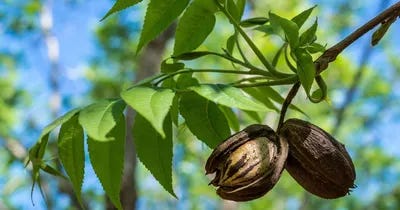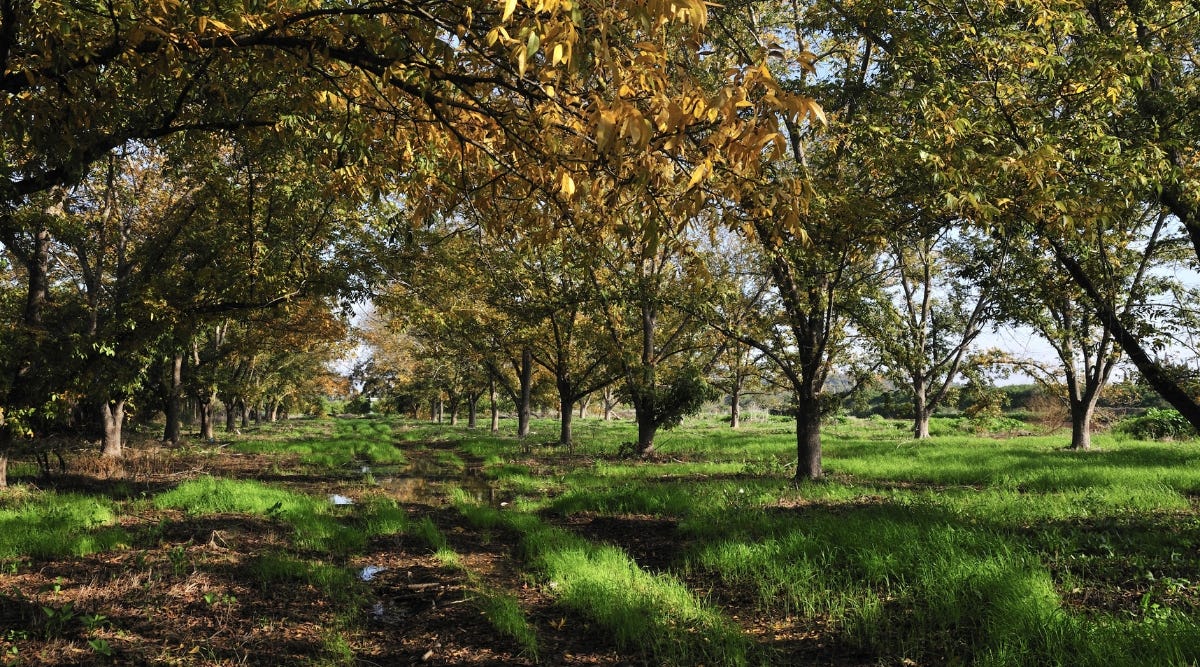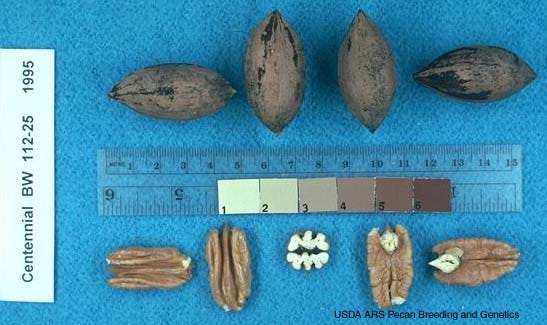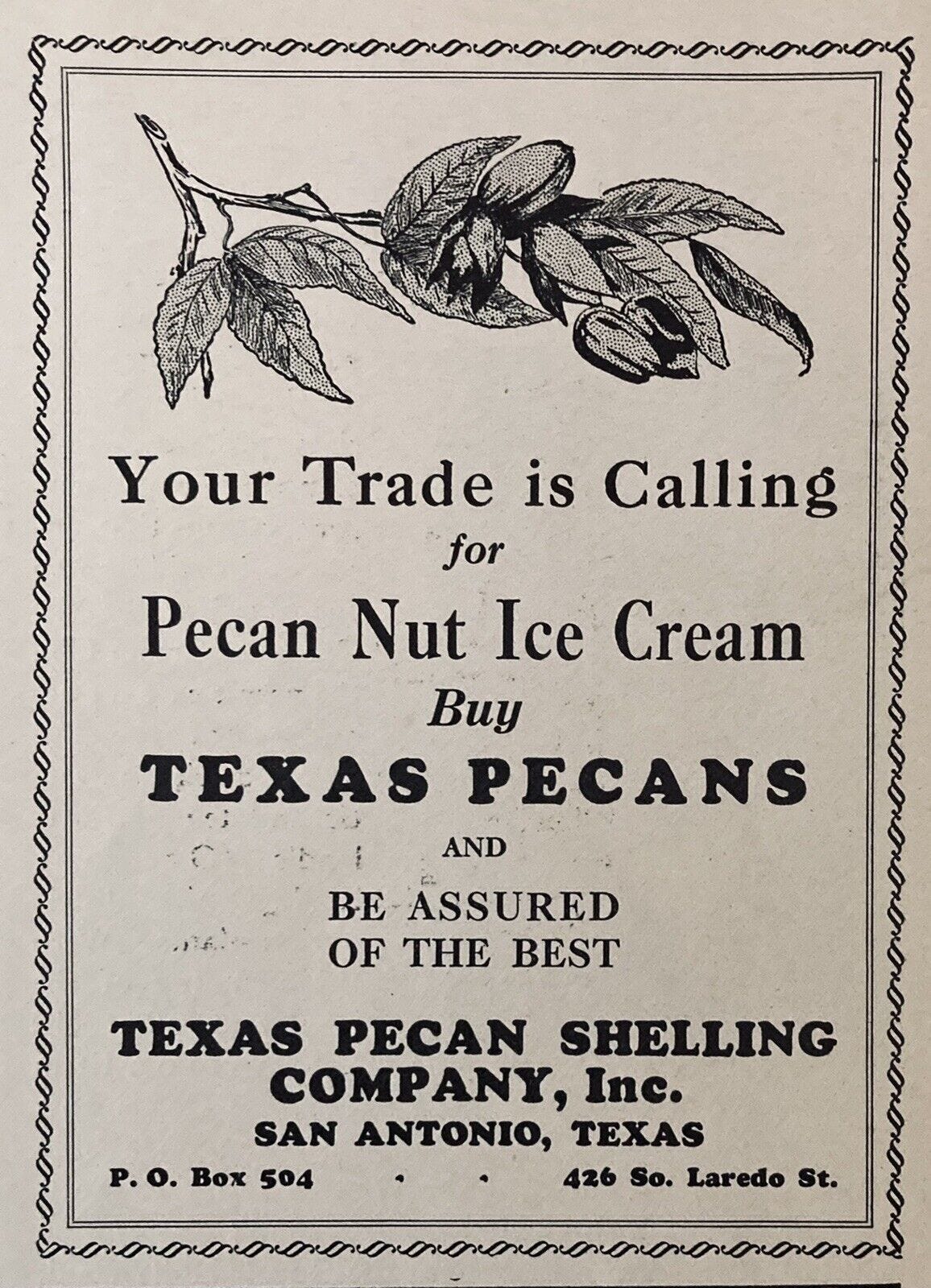Pecans
The Major North American Nut Crop has a surprising history
Nearly every person reading this piece has tasted the pecan, a marked difference from every other tree crop subject we have covered so far in this series. Pecans are without a doubt the most successful native commercial nut crop in North America, but what most folks don’t know is that this status is a relatively new phenomenon. In fact, unlike the other tree crops we’ve covered so far, the pecan has debatably had the least amount of human interference of any nut crop in North America. In many ways, the pecan was for generations the definition of what a sustainable, passive native agroforestry system could look like to feed communities healthy food with minimal inputs.
Pecan, derived from the Algonquin word “paccan” meaning “all nuts requiring a stone to crack” or “a nut too hard to crack by hand” (depending on who you ask) is arguably the best-known nut from North America.1 It’s the largest by a large number in terms of production, and yet despite this, it does not have a long history as a managed crop.2 Carya illinoinensis is native to eastern North America, however, the genus shows an intercontinental disjunction in its distribution between this population and East Asia. We discussed the unique conditions of Carya species in our piece on hickories.
The pecan found a home in the wet, loamy soils that stretched from the Gulf Coast through Northern Illinois (hence its scientific name). Where it thrives, however, is right on the edge of flood zones, where there is much less canopy competition, allowing the pecan to reach up to 180 feet.3 Indigenous groups expanded that range, planting the pecan as far north as New York. These trees aren’t just hardy and tolerant of a wide temperature range; they are aggressive growers with strong root systems stretching across the soil. Noted plant breeder Luther Burbank described the pecan as having “seedlings an inch high with roots from four to six feet in length.” Along with its aggression is a habit of creating dense groves of pecans, clustered closely to allow for easier pollination and healthy, diverse genetics.
Now unlike the hickory, the pecan can much more easily be broken out of its shell and consumed whole, allowing indigenous people to utilize the nuts in a variety of ways— from the whole nut to flours for breads, corn gruel, and even powcohicora— a fermented alcoholic drink.4 Researchers have suggested that squirrels and crows had begun the work of selecting thinner shells before humans discovered the tree, and are a large part of why the tree was easily made a central part of indigenous diets even beyond the scope of the tree range, through trade.5 This mutualist relationship between the squirrels and crows also aided in moving the pecan north.
The first human consumers of the pecan appear to be around the Mississippian cultures, which already had a diverse diet of over 1,100 species of plants. Despite these resources, the pecan became a staple food in their diet. Some communities would travel up to 100 miles to harvest pecans, depending on which grove produced large masts. These groves could be sustainable, despite the present issue of the pecan weevil, because of the abundance of the red-headed woodpecker, which thrived in pecan forests up until the mid-20th century and subsisted on the pecan weevil, along with other insects. As snags were cleared and suburbanization took hold, their home was lost and the weevil exploded.6
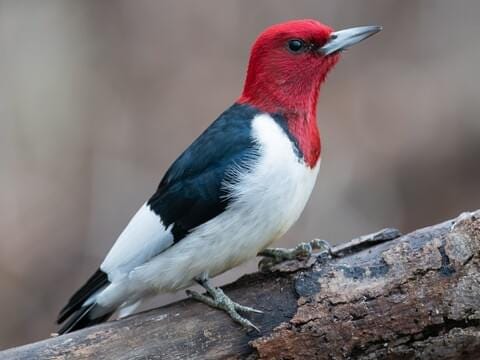

These nuts weren’t just harvested for eating but also a valuable trading commodity. For example, the Jumano Indians maintained thriving villages in the southwest while also having settlements in the Colorado and Conco Valleys, allowing them to move the pecan across the landscape for nearly a thousand miles. As far back as 6700 BC, evidence exists of humans eating pecans.7 Further, the Pecan’s range appears to have been extended by human management at this time, with pollen abundance across regions as far north as Iowa over 10,000 years ago, suggesting humans have likely been eating pecans even longer than the evidence suggests. Its quick movement north in comparison to other species suggests that the movement may have been facilitated by indigenous groups.
Upon colonists’ discovery of the nut, it was often confused with the walnut, described frequently as a ‘less oily, smaller walnut’.8, 9 Like the acorn and hickory, there is evidence that the nuts were stored in pits for future lighter season yields.10 Pecans have been proven to store for over a year, allowing for pecans to be consumed regardless of mast years, although oftentimes communities traveled, following the masts of the pecan.
Historically, pecans were processed similarly to other nuts, often with hammerstones and rock anvils to break the nuts apart. Given the popularity of pecans as a crop before mechanical processing (more on this later), we have extensive data on potential crop processing.
An average sheller was expected to process about a pound of nut meat an hour, putting pecans at around 3,136 calories per hour, with about 2/3rds of these calories remaining in whole/half nuts, unlike hickories. Outside of hickories and the largest burr oaks, this is the highest caloric return on any nut, but unlike hickories, pecans can be eaten as nuts and not drank as milk. Historically, there is little evidence that pecans were consumed using nut milk, suggesting that the nut milk of hickories was driven precisely because of the processing challenges.
Colonists Arrive
The pecan’s story, in the modern era, begins with the French botanist Andre Michaux, who saw how wild pecan stands were managed by the indigenous near Kaskaskia, Illinois, in 1819. He concluded that pecans needed to be grafted to consistently produce good quality pecans, as planting seeds did not produce consistent crops, and he attempted to graft pecans to black walnuts with no success. Only a few years later, Dr. Abner Landrum successfully grafted pecan buds to young hickory trees in Edgefield, South Carolina 1822. While they were a success, there was little interest in his work, and the event was quickly forgotten. Part of this erasure was because Dr. Landrum was involved in several different research areas, and dedicated most of his life to pottery, as his work in pecans was largely a curiosity and he did little to advertise his discovery. He was wildly successful in the field of pottery, and you can read more about his pottery work here.
It wasn’t for a few more decades that in New Orleans, the pecan became more than just a curiosity. Across Louisiana & Texas, the cotton industry stepped around the riparian zones where the pecans thrived due to extreme flooding, which the pecans could handle, while cotton would fail. With the continued survival of these pecan regions came an appreciation of the pecan both as animal feed (for pigs) and also as human food.
Pecans were known across the country, even if they weren’t a major food source. Part of the challenge of the pecan was that its seeds produced wildly variable trees, and grafting hadn’t proved successful to this point. However, another local pecan enthusiast, Dr. A.E. Colomb, attempted to address this issue by proving grafting was possible. He had repeatedly failed to graft from his favorite tree, and decided to ask his good friend, Telesphore J. Roman, to help him solve the riddle of the grafted pecan.
While Telesphore knew little about grafting, one of the people he had enslaved, Antoine, at Oak Alley Plantation in St. James Parish, Louisiana, was quite gifted at grafting, and successfully grafted sixteen pecan trees at Dr. Colomb’s request. This happened in 1846 or 1847, and a few years later Antoine grafted 110 more trees.11
Decades later, the owner of that same plantation— a man by the name of Hubert Bonzano— discovered the history of the few remaining trees that Antoine had grafted and shared the improved pecans at the Centennial Exposition in Philadelphia on the 100th anniversary of the nation. Because of this decision, Antoine’s grafts are known now as the Centennial pecan and were the first named cultivar of pecan. It is because of this grafting that the pecan as a domesticated crop began.
At that point, Antoine was dead. His son who had been living there had left the year before Bonzano brought to light these unique pecans. Despite this, coincidentally, Hubert talked to Roman’s son Henry and his nephew, Alcée Fortier and they both acknowledged that the tree was grafted by a gardener who was named Antoine and that he was a slave. Without this conversation, the story of Antoine would have been lost to history.
Over the following fifty or so years, the regions of Texas and Louisiana became the home of a newly forming pecan industry, although the old habits of attempting to grow pecans from seed refused to die. While pecan seedlings rarely show traits of their parents, many were hesitant to trust the grafting method, slowing the industry's growth even though grafting had been used for several other tree crops at this period.12
Slowly, but surely the southeast became inundated with improved pecans. States such as Florida jumped from 39,000 to 524,000 from 1900 to 1925. The southeast increased orchard pecan trees from 567,000 to 8.833 million in 25 years.13 So what changed? Advocates began to highlight the personal, agrarian-based testimonies of farmers— testimonies that often highlighted the farmer’s ingenuity the way we saw Russell Lord highlight the voices of farmers and their self-determination in his quarterly magazine The Land a few decades later. The goal was to highlight the potential for everyday planters who were hesitant to trust outside sources for how to change their farms, and that anyone could do it if they were willing.
Further, the USDA had recently had successes dealing with insect pressure, building goodwill with farmers and highlighting that sometimes the government can solve issues. Between these two pieces, the pecan as a crop thrived. As FDR’s administration took hold and advocated for perennial crops as we discussed here, the Pecan Stabilization Association designed a program to assist the export of pecans. The goal of this program was to establish a permanent foreign market. The government set price ceilings on pecans and subsidized farmers for the difference, making pecans affordable while also helping farmers stay profitable.14
The United States government worked with famous cooks and other public figures to find new ways to use the pecan, similar to what we’ve seen with corn. However, pecan wasn’t as easily absorbed into other foods, but pecans found a unique home in the desert section of many cookbooks. From that point on, the pecan continued to grow and evolve and find new ways to become a viable food for Americans, until the late 20th century when China found interest in the uniquely American nut.
Today, the pecan is the most widely-consumed North American nut across the globe. The pecan is consumed in deserts from the famed pralines of the southeast, driven by Creole culture, and pecan pie and butter pecan ice cream. The challenges of the pecan continue to exist as its production within a mono-crop exacerbates pest issues, and to this day these issues haven’t been addressed. However, the growth of the pecan industry gives us hope in what it looks like to incorporate native tree crops into our everyday diets.
If you’ve enjoyed this piece, which is equal to a 10-page chapter, of (so far) an 904-page book with 564 sources, you can support our work in a number of ways. The first is by sharing this article with folks you think would find it interesting. Second, you can listen to the audio version of this episode, #190, of the Poor Proles Almanac wherever you get your podcasts. Suppose you’d like to financially support the project, and get exclusive access to our limited paywalled content. In that case, you can become a paid subscriber on Substack or Patreon, which will both give you access to the paywalled content and in the case of Patreon, early access to the audio episodes as well.
McWilliams J (2013) The pecan: a history of America’s native nut. University of Texas Press, Austin.
D. H. Usner, “A Cycle of Lowland Forest Efficiency: The LateArchaic Woodland Economy of the Lower Mississippi,” Journal of Anthropological Research 39, no. 4 (Winter 1983): 434–437
William Cronon, Changes in the Land: Indians, Colonists, and the Ecology of New England (New York: Hill and Wang, 1983).
National Pecan Shellers Association (2016) History of pecans. http://www.ilovepecans.org/ pecans-101/history-of-pecans/
Flack, J.R. 1970. The spread and domestication of the pecan in the United States. Ph.D. Dissertation. University of Wisconsin, Madison. (unpublished )
T. R. Adkins, “The Red-headed Woodpecker Occasionally Win- tering in Alabama,” Wilson Bulletin 38, no. 3 (1926): 161.
Bettis, E. A., Baker, R. G., Nations, B. K., & Benn, D. W. (1990). Early holocene pecan, carya illinoensis, in the Mississippi River Valley near Muscatine, Iowa. Quaternary Research, 33(1), 102–107. https://doi.org/10.1016/0033-5894(90)90088-3
Londa Schiebinger, Plants and Empire: Colonial Bioprospecting in the Atlantic World (Cambridge, MA: Harvard University Press, 2004).
Rodney Howard True, “Notes on the Early History of the Pecan in America,” in the Annual Report of the Board of Regents, 72 (Washington, DC: Smithsonian Institution, 1919); Cecil Gregg, Pecans for Central Texas: The Establishment, Management, and Care of Pecans in the Area of San Marcos, Texas (San Marcos: Southwest Texas State University Press, 1975),
Hall, Grant D. “Pecan Food Potential in Prehistoric North America” Economic Botany 54(1):103-112, 200.
Works Project Administration, Slave Narratives: A Folk History of Slav- ery in the United States, released October 5, 2004, www.gutenberg.org /files/13602/13602-h/13602-h.htm, accessed April 20, 2011.
F. M. Burnette, William Carter Stubbs, and Harcourt Alexander Morgan, Pecans (Louisiana State Board of Agriculture, 1902), 851.
National Pecan Growers Association, Report of the Proceedings of the Annual Convention of the National Pecan Growers Association (Author, 1926), 91.
“News of Food,” New York Times, December 1, 1948; “News of Food,” New York Times, November 20, 1949; “Government to Buy Pecans,” New York Times, November 21, 1951.


